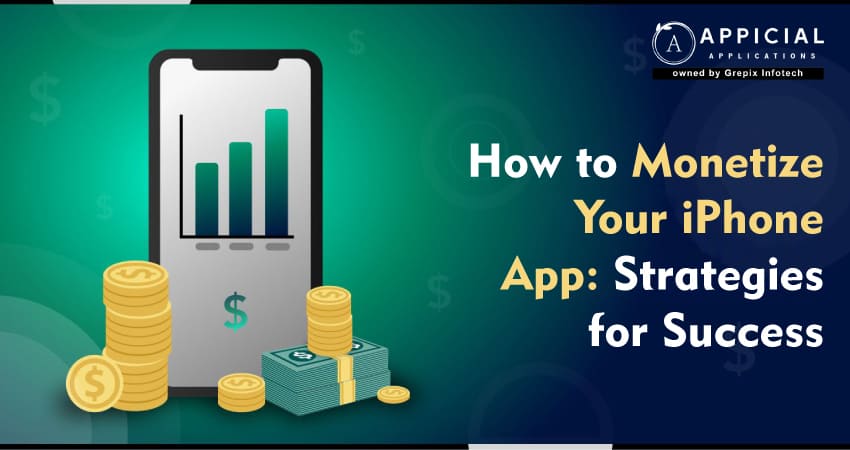
How to Monetize Your iPhone App: Strategies for Success
In today’s digital landscape, the iPhone app market presents a goldmine of opportunities for developers and entrepreneurs alike. With millions of apps vying for attention in the App Store, turning a simple idea into a profitable venture requires more than just innovative features and sleek design. It demands a strategic approach to monetization that not only attracts users but also keeps them engaged and willing to pay for your offerings. This guide explores the myriad of monetization strategies available for iPhone apps, from in-app purchases and subscription models to advertising and partnerships. Whether you are launching your first app or looking to optimize an existing one, understanding these strategies will help you navigate the complex path to financial success in the competitive world of mobile apps.
Monetizing your iPhone app involves understanding your audience and selecting the right revenue model. Strategies include in-app purchases, offering a freemium model with both free and premium features, integrating ads, and using subscription models for ongoing revenue. Paid apps and sponsorships or partnerships can also be effective. Implementing these strategies successfully requires continuous optimization through A/B testing, analytics, and user feedback. For entrepreneurs like Saleem, staying attuned to user preferences and continually improving your app can lead to a profitable and sustainable business.
Understanding Your Audience
Before diving into specific monetization strategies, it’s essential to understand your audience. Knowing who your users are, what they need, and how they interact with your app can provide valuable insights that guide your monetization approach.
- User Demographics: Identify the age, gender, location, and interests of your users. This information can help tailor your monetization strategies to better suit their preferences.
- User Behavior: Analyze how users navigate through your app, which features they use the most, and where they spend the most time. Understanding user behavior can highlight opportunities for monetization.
- Feedback and Reviews: Pay attention to user feedback and reviews. Users often provide insights into what they value and are willing to pay for.
Also Read: iPhone App Development vs. Android App Development: Pros and Cons
Monetization Strategies
There are several monetization strategies available for iPhone apps, each with its own set of advantages and challenges. Let’s explore some of the most effective methods.
1. In-App Purchases
In-app purchases (IAPs) allow users to buy virtual goods or premium features within your app. This model is popular among game developers but can be applied to various app categories.
- Consumable Purchases: These are items that users can buy and use up, such as in-game currency, health packs, or extra lives.
- Non-consumable Purchases: These are one-time purchases that provide permanent benefits, such as unlocking new features or removing ads.
- Subscriptions: Users pay a recurring fee for ongoing access to premium content or features. Subscriptions can be weekly, monthly, or yearly.
To succeed with IAPs, ensure that the items you offer provide real value to users and enhance their experience.
2. Freemium Model
The freemium model involves offering a basic version of your app for free while charging for premium features or content. This approach allows users to experience the app before committing to a purchase.
- Free Tier: Provide enough functionality in the free version to attract users and give them a taste of what your app can do.
- Premium Tier: Offer advanced features, exclusive content, or ad-free experiences for users who upgrade to the premium version.
The key to a successful freemium model is to strike a balance between the free and premium offerings, ensuring that the free version is valuable enough to attract users while enticing them to upgrade.
3. Advertising
Advertising is one of the most common ways to monetize free apps. By displaying ads within your app, you can generate revenue based on impressions (CPM) or clicks (CPC).
- Banner Ads: These are small ads displayed at the top or bottom of the screen. They are less intrusive but may generate lower revenue.
- Interstitial Ads: Full-screen ads that appear at natural transition points, such as between levels in a game. These ads can be more engaging but may disrupt the user experience.
- Native Ads: Ads that blend seamlessly with the app’s content and design, providing a less intrusive experience.
- Rewarded Ads: Users voluntarily watch ads in exchange for in-app rewards, such as extra lives or virtual currency.
To maximize ad revenue without compromising user experience, carefully choose ad formats and placement. Additionally, consider partnering with reputable ad networks to ensure high-quality ads.
4. Paid Apps
Charging users upfront to download your app is a straightforward monetization strategy. However, this approach has become less common as users often prefer free apps with optional in-app purchases.
- One-Time Purchase: Users pay a one-time fee to download the app and access all its features.
- Premium Pricing: Position your app as a premium product with unique features or content that justifies the cost.
While this model can provide immediate revenue, it requires a strong value proposition and effective marketing to convince users to pay upfront.
5. Subscription Model
The subscription model is particularly effective for apps that provide ongoing value, such as content services, productivity tools, or health and fitness apps.
- Content Subscriptions: Users pay for access to premium content, such as news articles, music, videos, or courses.
- Feature Subscriptions: Users pay for access to advanced features, such as cloud storage, premium support, or additional functionalities.
This model provides a steady stream of recurring revenue, making it easier to predict and scale your earnings. However, it’s crucial to continuously deliver value to retain subscribers.
6. Sponsorship and Partnerships
Partnering with brands or companies for sponsorship can be a lucrative way to monetize your app. This strategy involves integrating sponsored content or features within your app.
- Sponsored Content: Collaborate with brands to create content that promotes their products or services, such as sponsored articles, videos, or in-app events.
- Brand Partnerships: Partner with brands to offer exclusive features or content to your users, such as branded challenges, in-app discounts, or co-branded events.
Sponsorship and partnerships can provide substantial revenue while enhancing your app’s content and user experience. However, it’s essential to choose partners that align with your app’s theme and user interests.
Implementing and Optimizing Your Monetization Strategy
Once you’ve chosen a monetization strategy, implementing and optimizing it is key to maximizing revenue.
1. A/B Testing
A/B testing involves creating different versions of your app to test which one performs better. This technique can help you optimize various aspects of your monetization strategy, such as pricing, ad placement, or feature offerings.
- Pricing: Test different price points for in-app purchases or subscriptions to find the optimal price that maximizes revenue.
- Ad Placement: Experiment with different ad formats and placements to determine which ones generate the most revenue without disrupting the user experience.
- Feature Offering: Test different combinations of free and premium features to find the best balance that encourages upgrades.
2. Analytics and User Feedback
Utilize analytics tools to track user behavior, revenue, and engagement metrics. Analyzing this data can provide insights into what’s working and what needs improvement.
- Revenue Metrics: Track metrics such as average revenue per user (ARPU), lifetime value (LTV), and conversion rates to measure your monetization strategy’s effectiveness.
- Engagement Metrics: Monitor user engagement metrics, such as session length, retention rates, and active users, to understand how users interact with your app.
- User Feedback: Regularly collect and analyze user feedback to identify pain points and opportunities for improvement.
3. Continuous Improvement
The app market is dynamic, and user preferences can change over time. Continuously update and improve your app to keep users engaged and attract new ones.
- Feature Updates: Regularly add new features or content to keep your app fresh and exciting.
- Performance Optimization: Ensure your app runs smoothly and efficiently by fixing bugs and improving performance.
- Marketing Efforts: Invest in marketing to reach new users and retain existing ones. This can include app store optimization (ASO), social media marketing, and influencer partnerships.
Conclusion
Monetizing your iPhone app requires a deep understanding of your audience, a well-thought-out strategy, and continuous optimization. Whether you choose in-app purchases, a freemium model, advertising, paid downloads, subscriptions, or sponsorships, the key is to provide real value to your users while effectively generating revenue. By staying attuned to user feedback, leveraging analytics, and continuously improving your app, you can build a successful and profitable iPhone app.
As a leading mobile app development company, we understand that monetizing your iPhone app is a multifaceted journey that demands a strategic approach and continuous optimization. By leveraging various monetization strategies such as in-app purchases, freemium models, advertising, subscriptions, and partnerships, you can unlock the full revenue potential of your app. Our expertise lies in not only developing high-quality, engaging apps but also in providing ongoing support to optimize and scale your monetization efforts. By understanding your audience, analyzing user behavior, and staying adaptable to market trends, we help you transform your app into a profitable venture. Partner with us to ensure your app’s success in the competitive mobile landscape.
Launch your vision with our mobile app development company, where innovation meets excellence to create cutting-edge mobile solutions.







